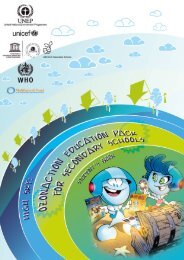Chapter 2. Progress towards the EFA goals - Unesco
Chapter 2. Progress towards the EFA goals - Unesco
Chapter 2. Progress towards the EFA goals - Unesco
You also want an ePaper? Increase the reach of your titles
YUMPU automatically turns print PDFs into web optimized ePapers that Google loves.
PROGRESS TOWARDS THE <strong>EFA</strong> GOALS<br />
Estimating <strong>the</strong> cost of achieving Education for All<br />
financing challenge with sufficient urgency.<br />
In <strong>the</strong> cases of Chad and Nigeria, <strong>the</strong> problem<br />
is less one of revenue mobilization than <strong>the</strong> low<br />
priority attached to education in general and<br />
basic education in particular.<br />
It should be emphasized that <strong>the</strong> ‘best effort’<br />
thresholds used are an imperfect guide to public<br />
policy. Revenue-raising capacity partly depends<br />
on export structures. Countries with large<br />
mineral assets may be better placed than o<strong>the</strong>rs<br />
to increase revenue collection. For countries<br />
emerging from conflict, such as Nepal and Sierra<br />
Leone, increasing <strong>the</strong> share of national income<br />
collected in revenue may be a slow process<br />
involving <strong>the</strong> restoration of credible public<br />
institutions and confidence in government. The<br />
estimates here should <strong>the</strong>refore be treated as an<br />
evaluation of what is possible under reasonable<br />
conditions, not as a full assessment of what each<br />
country can achieve in practice. With <strong>the</strong> data<br />
available, it is difficult to generate precise<br />
Education for All financing estimates for<br />
countries such as Afghanistan, Liberia and<br />
Sierra Leone, but <strong>the</strong>re are strong grounds for<br />
recognizing, as most aid donors have done, <strong>the</strong><br />
urgent need for a large up-front increase in<br />
education finance, given <strong>the</strong> limited capacity of<br />
<strong>the</strong>se countries’ governments to raise that finance.<br />
Donors need to increase aid<br />
to close <strong>the</strong> remaining gap<br />
Successive issues of <strong>the</strong> <strong>EFA</strong> Global Monitoring<br />
Report have drawn <strong>the</strong> attention of <strong>the</strong> donor<br />
community to <strong>the</strong> gap between aid levels and <strong>the</strong><br />
level of financing required to meet <strong>the</strong> Dakar<br />
targets. The revised global cost estimate suggests<br />
<strong>the</strong> gap is far larger than previously assumed. Any<br />
prospect of accelerated progress <strong>towards</strong> <strong>the</strong> 2015<br />
targets hinges critically on a scaled-up donor<br />
effort. The bottom-line message to emerge from<br />
<strong>the</strong> costing exercise is that two-thirds of <strong>the</strong><br />
additional resources required will have to be<br />
provided through aid.<br />
The residual aid component of <strong>the</strong> Education for All<br />
financing requirement can be extrapolated from<br />
<strong>the</strong> costing exercise. Figure <strong>2.</strong>49 summarizes <strong>the</strong><br />
financing gap that remains once prospects for<br />
additional domestic resources have been<br />
exhausted. Table <strong>2.</strong>11 provides an approximate<br />
breakdown of this financing deficit by education<br />
Figure <strong>2.</strong>49: Financing gaps are large and unlikely to be eliminated by current donor pledges<br />
Breakdown of annual resource needs to achieve basic education <strong>goals</strong><br />
40<br />
Constant 2007 US$ billions<br />
35<br />
30<br />
25<br />
20<br />
15<br />
Average annual<br />
resources needed<br />
to finance <strong>EFA</strong><br />
(2008-2015)<br />
US$36 billion<br />
Financing gap<br />
US$16 billion<br />
US$4 billion<br />
US$3 billion<br />
Additional resources<br />
from domestic prioritization<br />
Additional domestic resources<br />
from economic growth<br />
Financing gap<br />
Current aid to basic<br />
education (2006-2007)<br />
US$3 billion<br />
Additional aid to basic<br />
education if Gleneagles<br />
US$2 billion<br />
Remaining<br />
commitments met<br />
shortfall<br />
US$11 billion<br />
The financing<br />
gap for basic<br />
education<br />
is around<br />
US$16 billion<br />
annually<br />
10<br />
5<br />
Current<br />
estimated<br />
resources<br />
US$12 billion<br />
0<br />
Notes: Breakdown of annual resource needs does not add up to <strong>the</strong> total due to rounding. The percentage increase in aid<br />
between 2005 and 2010 associated with <strong>the</strong> Gleneagles targets (see <strong>Chapter</strong> 4) are usual to project 2005 basic education commitments<br />
to 2010 for each country covered.<br />
Sources: EPDC and UNESCO (2009); OECD-DAC (2009d).<br />
129
















